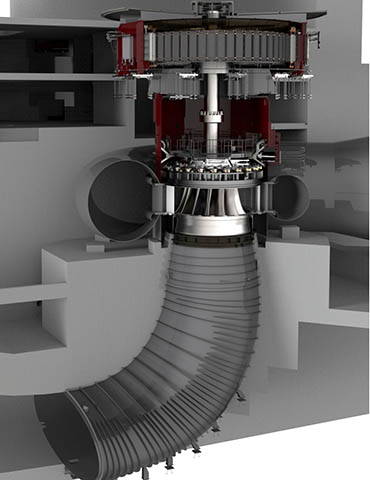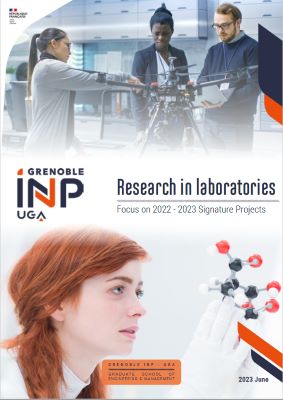Innov’hydro, the structuring project of the competitive clusters (PSPC) involves five joint Grenoble INP laboratories with the CNRS and Joseph Fourier University (LEGI, 3SR, GIPSA-lab, G2ELab and LCIS) and aims to review the assembly composed by the turbine and the electric generator. Within this consortium, LEGI will be responsible for developing digital simulation models of turbulence, cavitation phenomena and breakaway which occur in flows based on various parameters (height, flow rate, speed, etc.). These sophisticated models will be validated by experiments on the ALSTOM test platforms. They will be used to design new turbines whose geometry must be accurate to within one twelfth millimetre (on objects several meters long, this involves an extremely low margin for error!).

“Based on the digital simulation results, the researchers at 3SR will also develop experimental protocols to study the fatigue of materials in the laboratory, explained Didier Imbault, professor at Grenoble INP – Ense3 and researcher at 3SR. The mechanical stresses will be reproduced in the laboratory on test benches in order to test the material composing the turbines with the same mechanical stresses as in actual conditions”. At the same time, GIPSA-lab will focus on the instrumentation-control part. “Using the existing machine as a basis, we will try to make the current machines as compatible as possible with the new constraints, explained Mazen Alamir, CNRS research director at GIPSA-lab. To this end, we will develop new algorithms to calculate and obtain the minimum response time that can be guaranteed for these machines without damaging the equipment. The turbines and actuators will be brought to the limits of their operating zone without crossing the red line”. This involves finely modelling the system (equipment, flow mode, etc.) in order to get close to the unstable zones without crossing them. “Of course, manufacturers will also be able to use our simulator to develop new turbine concepts”. For its part, the LCIS (systems design and integration laboratory) in Valence that specialises in RFID technologies will develop passive and identifiable wireless sensors that will be used in the future for monitoring works among other things. Finally, G2Elab will be responsible for efficiently converting the mechanical energy into electric power.
Other projects of the same type are underway, some of which in connection with the Alstom regional centre of excellence project prefigured by the Hydro’like chair. One example is the Platform project, which started in late 2013 within the context of the call for projects of the Fonds Unique Interministériel (FUI - Single interministerial fund).

“Based on the digital simulation results, the researchers at 3SR will also develop experimental protocols to study the fatigue of materials in the laboratory, explained Didier Imbault, professor at Grenoble INP – Ense3 and researcher at 3SR. The mechanical stresses will be reproduced in the laboratory on test benches in order to test the material composing the turbines with the same mechanical stresses as in actual conditions”. At the same time, GIPSA-lab will focus on the instrumentation-control part. “Using the existing machine as a basis, we will try to make the current machines as compatible as possible with the new constraints, explained Mazen Alamir, CNRS research director at GIPSA-lab. To this end, we will develop new algorithms to calculate and obtain the minimum response time that can be guaranteed for these machines without damaging the equipment. The turbines and actuators will be brought to the limits of their operating zone without crossing the red line”. This involves finely modelling the system (equipment, flow mode, etc.) in order to get close to the unstable zones without crossing them. “Of course, manufacturers will also be able to use our simulator to develop new turbine concepts”. For its part, the LCIS (systems design and integration laboratory) in Valence that specialises in RFID technologies will develop passive and identifiable wireless sensors that will be used in the future for monitoring works among other things. Finally, G2Elab will be responsible for efficiently converting the mechanical energy into electric power.
Other projects of the same type are underway, some of which in connection with the Alstom regional centre of excellence project prefigured by the Hydro’like chair. One example is the Platform project, which started in late 2013 within the context of the call for projects of the Fonds Unique Interministériel (FUI - Single interministerial fund).
SUMMARY
- Imagining the hydraulic machines of the future
- Hydroelectricity: an energy of the future
- Innov'hydro: a multi-disciplinary project
- "We will not be the best on our own"
- Tidal turbines in rivers and at sea
- LCIS transforms RFID labels into sensors
- Micro hydropower plants to provide rural areas with electricity





